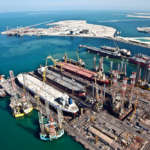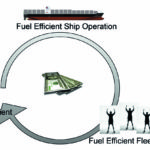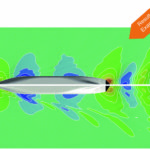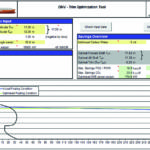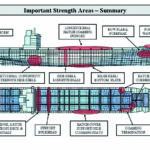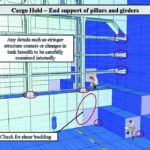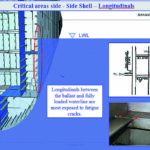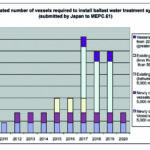A revolution of global transportation – and a look into the future. Part three: ships in operation.
Owners, managers and operators of the worldwide container ship fleet are today facing a number of significant challenges. The oversupply[ds_preview] of tonnage in almost all segments, low freight and charter rates and, not least, high fuel oil prices have put the shipping market under a lot of pressure. As a consequence, these aspects are causing all those in the industry to have a high cost awareness regarding the entire scope of service levels.
The lines are reorganising their service frequencies to suit market requirements. Charter periods are short and rates are down to operating expenses or even below. Operators have higher demands and owners are endeavouring to keep their vessels in service. Fuel efficiency is at the top of the agenda and a vessel’s speed and consumption ratio are one of the main topics when a ship is being considered for a new charter. Owners are putting a lot of effort into this area in order to comprehensively document their vessels’ performance. In addition to administrative requirements that are forcing investments to meet the new emissions limitations, tighter rules for the treatment of ballast water will also have to be complied within the near future.
Further administrative requirements are in the pipeline. The onboard Ship Energy Efficiency Management Plan (SEEMP) will be compulsory very soon and more and more flag states are ratifying the MLC 2006.
Keeping operational costs under control
Fuel cost
In the prevailing tough market, both liner operators and charter owners are showing special awareness of cost reductions and/or control. Ship operators are suffering from low charter rates and unemployed tonnage, while fuel saving measures are number one on the agenda for all of them. As the fuel oil price has again reached 750 $ per tonne and is continuing to rise, these measures are essential to keep a vessel in service. During the last crisis, slow steaming had already successfully been introduced and proved that fuel and thus expenses could be saved and tonnage could be kept in service. However, fuel efficiency can be further improved. The »DNV Fuel Saving Guideline – For Container Ships«, published in 2011 and issued together with the Hamburg Ship Model Basin HSVA, provides impartial expert advice on available technology and the cost effectiveness of fuel-saving measures which are relevant for container ships. Besides many design features to be considered, especially for newbuildings,
the guideline also provides an overview of operational measures to save fuel.
For a lot of measures the initial ship design is of course crucial. But there is also a big potential on the operational side. Thus both the fuel efficiency of ship operations and the fleet management should be evaluated. If the fleet management side in shipping companies has already been successfully optimised during the past decade, the main potential in the running fleet lies in most cases in fuel saving operations. Key topics here are:
• Main energy consumers – tuning and efficiency
• Speed optimisation and voyage planning
• Trim and draft optimisation
• Bunkering strategy and procedures as well as fuel quality monitoring
• Ship performance and operational procedures
Especially performance monitoring and trim/draft optimisation should be subject to a more in-depth evaluation as innovative tools are available and investments are comparatively reasonable even in hard times.
Vessel performance monitoring & benchmarking
Voyage execution and the related possible savings are often underrated
In order to assess the present performance status, measures must be applied that enable the operator to act and possibly change certain parameters. This includes proper data collection on board and regular performance reports (e. g. daily at noontime) to be sent to owners, which should have centralised data storage for their entire fleet. Easy, uniform and reliable data transfer from ship to shore is therefore necessary.
The shore staff must follow this up closely and give case-by-case feedback to the ship’s command. Data processing has to provide the ability to compare and benchmark the whole fleet. This initiates a certain competition amongst vessels. Efficient key performance indicators (KPIs) and a thorough reporting scheme also mean the management can be told to act affirmatively.
DNV supports the setting-up of reporting and benchmarking software or the enhancement of the functionality of existing reporting software. This enables a shared workload and commitment to success. As a direct follow-up of the vessel’s performance (noon reports or special performance reports), off-spec performance can be intuitively reported (traffic light). The necessary calculations are based on state-of-the-art numerical methods and will be tailored to available data. The documentation helps to avoid costly discussions about speed/consumption claims.
Asset management
Maximum possible time in service
During times when charter rates are under pressure, it is essential to keep the vessel in service for as many days as possible. Today, some owners already go for an extended dry docking interval of 7.5 years. In order to benefit from this and permanently monitor the vessels’ condition, company maintenance systems have been installed.
An operational hull planned maintenance system improves the asset management and provides more predictable maintenance costs. Close cooperation with the classification society makes the situation even more beneficial. Frequent inspections mean that potential problems may be discovered at an early stage. The inspections can be carried out when time allows and compartments are available. Trained seagoing officers with well-established programmes and visual inspection manuals can conduct the inspections during long sea passages. A working record-keeping system containing photographs and acceptance criteria is a necessary feature. Good record-keeping and documentation on board empowers the personnel to take responsibility. The management office keeps the cross-fleet overview, revealing fleet trends and sister ship experience.
Hull PMS
A modern survey scheme
The DNV hull PMS (planned maintenance system) puts the surveyor in a position to evaluate the results of inspections carried out by ship crew and/or shore personnel and reported in the PMS. Such inspections can be waived provided the attending surveyor is satisfied that the condition complies with the rules.
Areas of attention
Inspectors need to know what they are looking for. DNV has experience of ships built to all class standards through class transfers of ships built to other class societies’ standards. Typical defects and critical areas are identified and updated and included in an inspection manual, thus providing guidance to inspectors. Side shell fatigue can be an issue on older container ships. Fatigue cracks develop over time, depending on the design details and ship operations. The expected fatigue life can be calculated and provide guidance on inspection frequency.
The timely discovery of fatigue cracks will reduce the risk of more comprehensive repairs and unscheduled off-hire periods. The cracks can be repaired by fitting brackets according to calculated design modifications. To give an example: Before its first class renewal survey, a ship with side shell fatigue crack problems had been transferred to DNV class about 4.5 years after delivery. The problem was minimised as the class society and manager had cooperated on a hull PMS system, with class being involved at once in providing a solution.
Two well known container ship managers have operated hull PMS pilot schemes in cooperation with DNV for more than five years now. The new survey arrangement is based on and incorporates this experience. Fully fledged IT-based reporting and maintenance tools are available from DNV but are not a prerequisite for the hull PMS survey arrangement. A simplified spreadsheet reporting tool is available and is being successfully used by managers. This may serve as a starting point for companies that are new to hull planned maintenance systems or have their own systems in place already.The first pilot projects with German customers will start soon.
Administrative requirements and changes
The following administrative requirements/changes are the most important for the container ship fleet in operation:
• IMO/ECA
• Ballast water treatment
• MLC 2006
• SEEMP
Upcoming regulative changes related to emissions to air have been discussed earlier and the shipping companies are well aware of these, so we do not deem it necessary to discuss them in more detail here.
A very important change and real challenge are envisaged when the Ballast Water Convention comes into force. This will be twelve months after it is ratified by more than 30 states representing 35 % of the world fleet. As more than 30 states have already ratified it, the shipping world is now (status: March 2012) 8.56 % of the world fleet away from the entry into force of the convention. This could take place quickly, as Panama alone could bring in the missing capacity.
The big challenge will be to retrofit all the vessels with ballast water treatment (BWT) systems between 2015 and 2020. The availability of systems, detailed technical features including type approvals etc., and last but not least the investment volumes have to be clarified soon if ships are to be ready. MLC 2006 has been ratified by 22 countries with more than 55 % of the world tonnage so far. Eight countries are still missing and the convention will enter into force for all ships above 500 GT from »MLC countries« or trading in »MLC ports«. This is also expected to happen soon and the shipping industry has to be well prepared for this, too.
Ship Energy Efficiency
Management Plan
Another regulation soon to be in force is the introduction of an Ship Energy Efficiency Management Plan. The SEEMP was adopted at the MEPC 62nd session in July 2011, under mounting pressure from the industry and authorities, and will become mandatory for all vessels at their first renewal or intermediary survey after 1 January 2013.
SEEMP – what exactly is it?
IMO – MEPC.1/683 guidance for the development of a SEEMP recognises that operational efficiencies will make an invaluable contribution to reducing global carbon emissions. The SEEMP’s main purpose is to establish a mechanism for a company and/or ship to improve the energy efficiency of the ship’s operation that is preferably linked to a broader corporate energy management policy. The SEEMP is to be customised to suit the characteristics and needs of individual companies and ships.
The guideline itself can be found at the IMO website (www.imo.org). Please note that this will be updated over the coming months, and whilst it is not expected to change too much, it will be modified.
Going beyond compliance
The IMO guidance for the development of a SEEMP for ship owners and operators is acknowledged and fully supported. The key difference in the outcome will be in its implementation. Developed SEEMPs are available for customers around the world with a systematic, structured and cost effective approach to each project. And as the overriding goal of having a SEEMP is to use less fuel (relatively speaking), the outcome of a successfully deployed SEEMP is reduced maintenance costs, lower running hours and fewer emissions.
DNV‘s approach remains fully compliant with the IMO guidance and builds on it further by placing emphasis on the delivery and implementation of the plan. By drawing on insight into leading practices in a range of shipping segments, class brings applied and practical intelligence to the SEEMP development process in order to ensure the shipowner or operator has the best possible chance of not only achieving compliance but also reaping the benefits of lower consumption and costs.
Summary
Ship operators and managers must reduce and control their operational costs. Comprehensive tools are available for this purpose or can be developed individually. In future, competitiveness will be defined by fuel consumption and its dependable recording. PMS systems help to ensure dependable ship operations and allow improved planning in order to avoid expensive and inefficient off-hire. To cope with expected new regulations in future, ship operators must closely cooperate with the supply industry as well as with classification societies.
With its long experience and expertise, reliable tools and individually adapted consultancy services, DNV is well prepared to assist the maritime industry.
Frank Hensel






